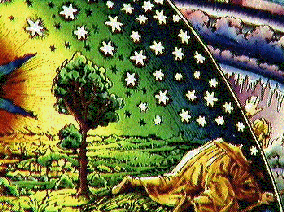

From the dawn of history until the beginning of the 17th century the known universe
consisted of only 8 bodies:
Earth
Sun
Moon
Mercury
Venus
Mars
Jupiter
Saturn
plus the "fixed" stars. These are the ones that can
be seen easily
without any optical instruments.
In Europe, the prevailing view was the Ptolemaic
system with the Earth at the center and the other bodies revolving around it.
In 1610 Galileo
first turned a telescope on the heavens and the universe exploded.
By the end of the 17th century, 9 new bodies had been discovered
and Copernicus's heliocentric
theory was widely accepted.
The total number of known bodies had more than doubled to 17:
Callisto 1610 Galileo
Europa 1610 Galileo
Ganymede 1610 Galileo
Io 1610 Galileo
Titan 1655 Huygens
Iapetus 1671 Cassini
Rhea 1672 Cassini
Dione 1684 Cassini
Tethys 1684 Cassini
Only 5 new bodies (not counting comets)
were discovered
in the 18th century (all by William Herschel)
bringing the total to 22:
Uranus 1781 Herschel
Oberon 1787 Herschel
Titania 1787 Herschel
Enceladus 1789 Herschel
Mimas 1789 Herschel
The number of bodies in the solar system increased dramatically in the
19th century with the discovery of the asteroids
(464 of which were known at by 1899)
but only 9 more "major" bodies were discovered.
The number of major bodies rose to 31 (almost double the 17th century total):
Neptune 1846 Adams, Le Verrier
Triton 1846 Lassell
Hyperion 1848 Bond
Ariel 1851 Lassell
Umbriel 1851 Lassell
Phobos 1877 Hall
Deimos 1877 Hall
Amalthea 1892 Barnard
Phoebe 1898 Pickering
In the first three quarters of the 20th century 13 more major bodies (and thousands of comets and asteroids)
were discovered bringing the total up to 43:
Himalia 1904 Perrine
Elara 1905 Perrine
Pasiphae 1908 Melotte
Sinope 1914 Nicholson
Pluto 1930 Tombaugh
Carme 1938 Nicholson
Lysithea 1938 Nicholson
Miranda 1948 Kuiper
Nereid 1949 Kuiper
Ananke 1951 Nicholson
Janus 1966 Dollfus
Leda 1974 Kowal
Charon 1978 Christy
27 more small moons were discovered by the two
Voyager spacecraft:
Adrastea 1979 Jewitt
Metis 1979 Synnott
Thebe 1979 Synnott
Epimetheus 1980 Walker
Atlas 1980 Terrile
Calypso 1980 Pascu et. al.
Helene 1980 Laques et. al.
Pandora 1980 Collins et. al.
Prometheus 1980 Collins et. al.
Telesto 1980 Reitsema et. al.
Puck 1985 Voyager 2
Belinda 1986 Voyager 2
Bianca 1986 Voyager 2
Cordelia 1986 Voyager 2
Cressida 1986 Voyager 2
Desdemona 1986 Voyager 2
Juliet 1986 Voyager 2
Ophelia 1986 Voyager 2
Portia 1986 Voyager 2
Rosalind 1986 Voyager 2
Despina 1989 Voyager 2
Galatea 1989 Voyager 2
Larissa 1989 Voyager 2
Naiad 1989 Voyager 2
Proteus 1989 Voyager 2
Thalassa 1989 Voyager 2
Pan 1990 Showalter
Dozens more small moons have been discovered in recent years with large ground based telescopes and CCD cameras. There are well over 100 now known; See JPL's site for more details.

|
|---|